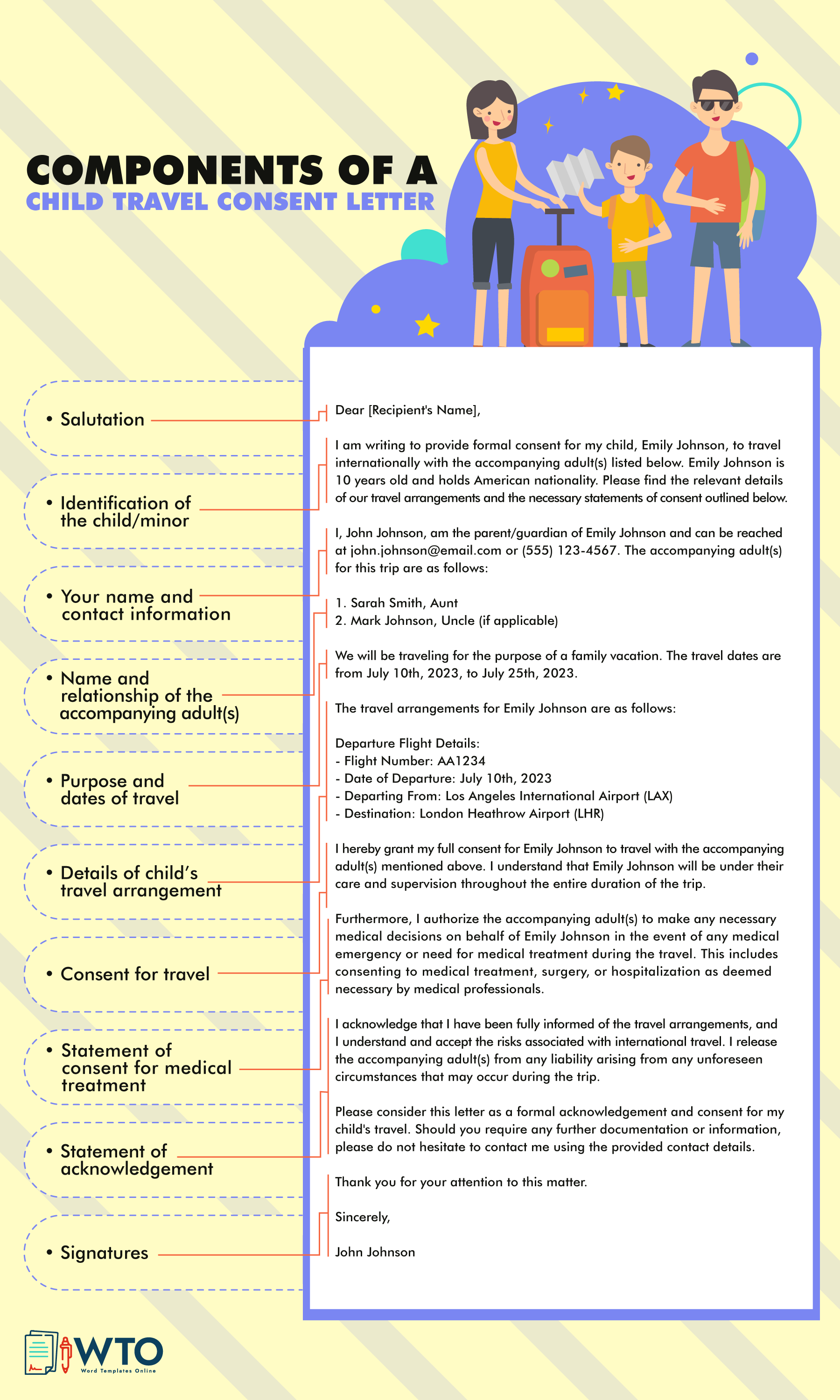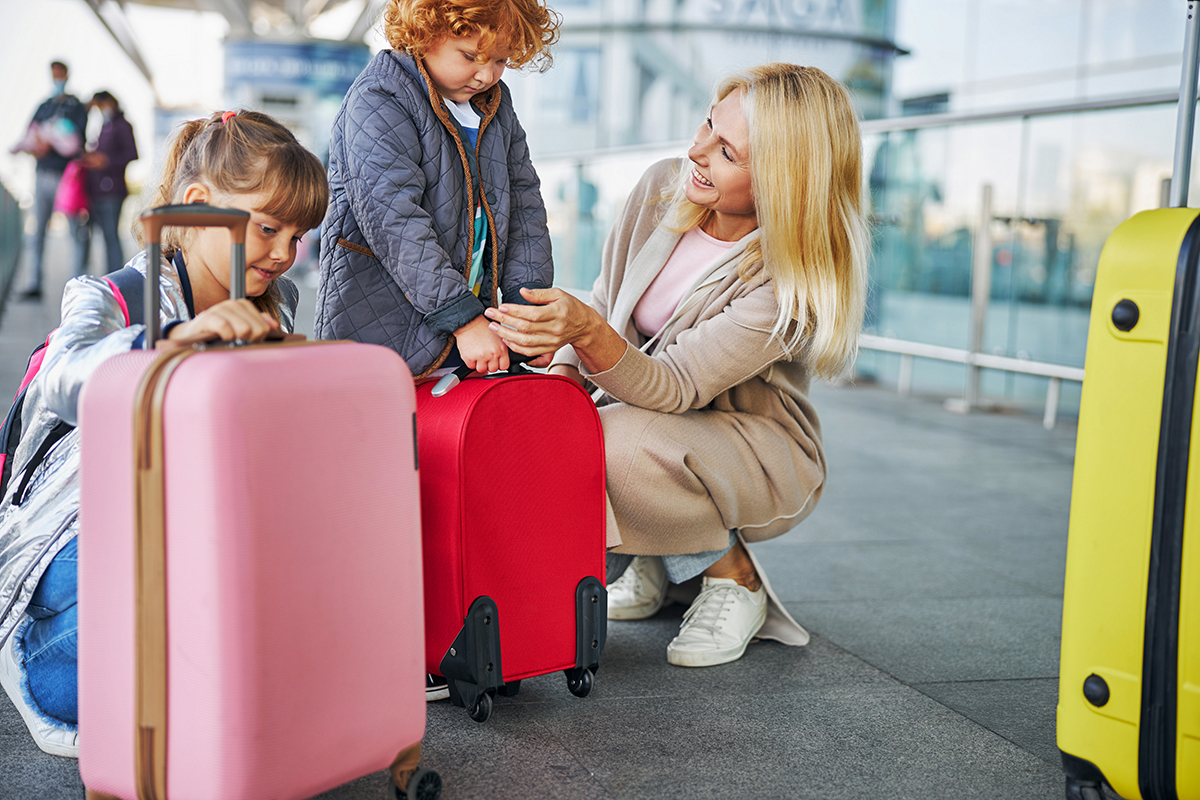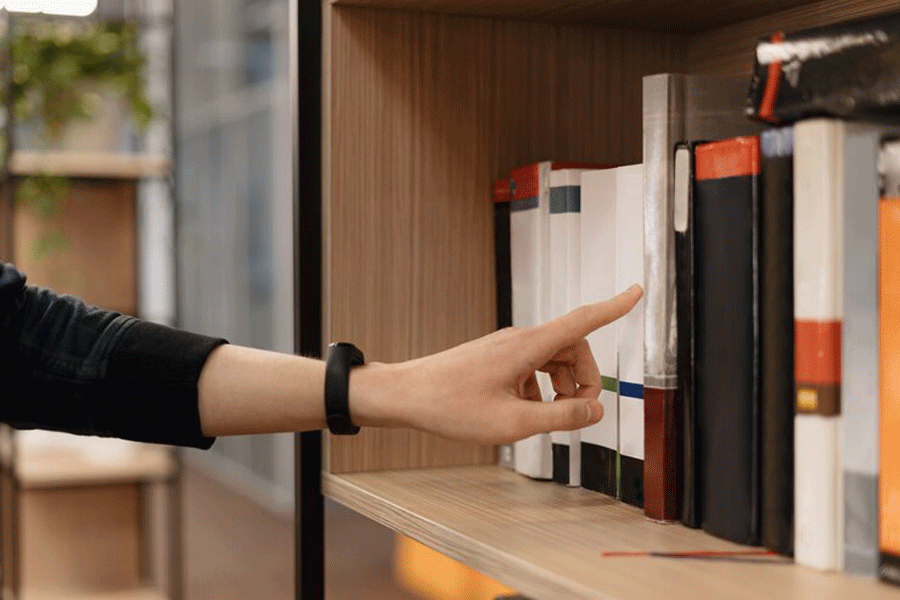A child travel consent letter is defined as a legal document written by the parent or legal guardian granting permission to another party (individual, group, or entity) to travel with their child.
It is used for both domestic and international flights. If only one parent is available to sign the letter, then one signature is sufficient. If both parents are available, then it would be best for both to sign. The letter is needed as legal proof that the parents authorized another person, such as a friend, grandparent, or school group, to accompany their child during travel. Additionally, it is written when the child travels without parents or legal guardians. It should include travel details such as date, destination, and emergency contact.
In addition, it may include written consent for medical treatment, which is recommended for clarity and safety but not necessarily required by law. During travel, it is presented to airline personnel, immigration officials, and other authorities, such as border agents, to verify authorization and protect children by preventing child abduction and trafficking. Furthermore, it also protects the legal guardian as it proves that the parental responsibilities were temporarily transferred to the other party.
This article will discuss when a letter of consent for a child’s travel is needed and the information to include in it. It also discusses the legal factors to consider when writing such a letter and tips to make it more effective and compliant.
When Do You Need a Letter of Consent for the Travel of a Minor Child?
A letter of consent for a child to travel is used to show that you granted the named party authorization to travel with your child under various circumstances.
Here are scenarios when the letter would be required:
- The authorities may require this letter to identify the accompanying party when your child travels internationally in your absence. It also indicates the duration of the travel period and the destination.
- Airline and transportation authorities will require consent letters for domestic flights whenever your child travels within the country without the mother or with someone who is not the minor’s parent or legal guardian.
- These letters should be written for school trips or sports events where a minor is expected to travel. The designated chaperone or supervisor in such letters is the school.
- The letter can allow a minor to travel for emergency reasons, such as medical or family reasons. It shows the person authorized to accompany the child during their travel.
- You must write a letter of consent when the child travels with grandparents or relatives as they are not legal guardians even though they are related to you.
- A letter of consent is required when one parent is traveling with the minor.
For instance
If the mother is a single parent traveling with the child, the father must issue a letter with written consent. This is required when the other parent has custody or legal rights to the minor.
- When guardians or other legal representatives, such as attorneys or social workers, travel with the minor, a letter showing your authorization for the travel is required.
Information to Include in a Consent Letter for a Child to Travel
The components will usually be consistent in all consent letters. However, the specifics will vary based on the purpose of the letter and travel details. You can review several samples of parental letters of consent for a child to understand how to structure one for your minor.
With that in mind, below is a discussion of what information you must include in the letter:
Identification of the child/minor
Identification details, such as the child’s name, passport number, date of birth, etc., should be included in the letter for the traveling child. This information must be provided on official documents. This is to avoid any misidentification, which can lead to delayed travel.
Name and contact information of the parent or legal guardian
You ought to write your identification information, including your full name and contact details such as phone number, address, and email address, in the letter. Both parents can provide their information if it is available. The information is used to verify your legal authority over the minor. Officials use the contact details whenever they want to verify any information.
Additionally, this information would also be helpful in emergency cases. If there is an alternative emergency contact, indicate their name and contact information in the letter.
Name and relationship of the accompanying adult(s)
The letter must identify the person or party your child will travel with. This can be a relative, friend, or school colleague. So, include their name, relationship to you and your child, and contact details. This component is significant because it helps authorities determine who you have authorized to protect your child during the trip. Also, this information grants the named party the legal authority to make decisions regarding your child in your absence.
Purpose and dates of travel
You must provide travel specifications in the letter so that authorities can determine the scope of the trip and be certain that it is within good reason. Specify the purpose of the trip, whether it is a summer vacation, family holiday getaway, friend’s birthday, etc. Then, state the destination and length of travel by indicating the start and end dates.
Details of the child’s travel arrangement
The letter must also state the modes of transport you have consented to your child using—whether it is by train, flight, cruise, or road. This must be supplemented by travel specifications such as the name of the airline or cruise, ticket number, departure, and arrival times, and accommodation details such as the name and address of the specific hotel. This information is necessary to ensure your child arrives safely at the specified destination.
Consent for travel
A statement of consent to travel must be explicitly written in the letter. The statement must specify what authorization is being issued, by whom and to whom, for what reasons, and for how long. So, specify that you have granted the named person or entity to accompany your child when traveling on the specific trip for the specified purpose and dates.
Statement of consent for medical treatment
If you want to grant the accompanying party the legal right to make medical decisions in your absence, you should include a statement of consent for this in the letter. You can include any important medical care information that needs to be conveyed, such as special dietary needs, medication, and equipment your child must always have when traveling. Granting this consent is important for protecting your child in cases of medical emergencies.
Statement of acknowledgment
An acknowledgment statement in a consent letter declares that you are aware of the potential risks involved when your child travels without you. It is also an attestation that you understand the content of the letter and the child’s travel arrangements, and you decide to allow your child to travel in the company of another party. This exempts the accompanying party from liability for any harm or loss to your child during the trip.
Signatures and notarization
You and the accompanying party must sign the document as proof of acceptance of any terms and conditions of the letter of consent. Your signature attests that you agree to relieve your legal responsibility for the child during the stated travel period and for the specified reasons. The other party’s signature is proof of acceptance of the responsibility of the minor for the specified reasons and duration. The signed letter must then be notarized to validate its authenticity under the law.
note
Instead of writing the consent letter from scratch, you can download templates to help you grant another party authorization to travel with your child. You can also reference online samples to learn how to create an effective letter of consent. This saves you time and effort. You will find samples and templates in PDF format, guaranteeing that the document’s format and structure remain intact across different editing processors.

Samples Travel Consent Letters
The following free sample letters aim to assist you in articulating your consent for your child to travel without you. Use these samples as a foundation to construct letters that reflect specific situations, concerns, and any additional information relevant to the travel arrangement.
Permission Letter for Child to Travel with Grandparents
To Whom It May Concern,
I, Norah Abraham, am the lawful parent/guardian of Robin Abraham, born on January 5, 20XX. I am writing to grant my full consent for Robin Abraham to travel with her grandparents, John and Mary Johnson, from January 10, 20XX, to January 20, 20XX.
During this period, they will be visiting Paris, France, and can be contacted at +1 555-0101. I authorize John and Mary Johnson to make any travel-related decisions and medical decisions if necessary.
I have attached a copy of my ID and Robin’s birth certificate for verification purposes. Please feel free to contact me for any further clarifications at +1 555-0202.
Thank you for your attention to this matter.
Sincerely,
[Signature]
Nora Abraham
Permission Letter for Child to Travel for an International Sports Event
To Whom It May Concern,
I, Jane Smith, am the lawful parent/guardian of Sarah Smith, born on January 5, 20XX, and a participant of the Anytown Junior Soccer League. I hereby give my consent for Sarah Smith to travel internationally to Tokyo, Japan, for the Junior World Soccer Tournament from March 15, 20XX, to March 25, 20XX.
Sarah Smith will be under the supervision of Coach Michael Brown and can be contacted at +1 555-0303. I authorize Coach Michael Brown to make any necessary travel and medical decisions during the trip.
Enclosed are copies of my ID, Sarah’s birth certificate, and passport for verification. For any further information or emergency, please contact me at +1 555-0202.
Thank you for ensuring the safety and well-being of my child during this event.
Sincerely,
[Signature]
Jane Smith
Key Takeaways
The key aspects that make these sample letters useful guides for anyone looking to write a permission letter for a child’s travel are the following:
- Both letters are clear and specific in their purpose. They clearly state the name of the child, the dates of travel, the destination, and with whom the child will be traveling. This specificity ensures that the intent of the letter is immediately understood and leaves little room for ambiguity.
- Each letter begins with the sender’s full name and address, followed by the date. This formal structure is essential for official documentation and helps in verifying the authenticity of the letter.
- In both letters, the parent authorizes specific individuals (grandparents in the first letter and a coach in the second) to make decisions on behalf of the child, including medical decisions. This delegation is crucial, especially in situations where the parent is not present.
- The attachment of identification documents like the parent’s ID and the child’s birth certificate or passport adds credibility to the letters and aids in the verification process, which is particularly important for international travel.
- Both letters provide contact numbers for the parent, ensuring that there is a direct line of communication available in case of emergencies or necessary clarifications.
- The tone of both letters is professional and courteous. This is key in formal communications, especially when addressing authorities or institutions that might be involved in facilitating or overseeing the child’s travel.
- The letters end with a note of thanks or acknowledgment, which adds a personal touch while maintaining the formality required in such correspondence.
These letters serve as effective guides and are particularly useful for anyone looking to draft a similar letter, ensuring both the child’s safety and the parent’s peace of mind during the child’s travels. They provide a clear framework that can be easily adapted for different scenarios, ensuring all necessary information is conveyed in a respectful, concise, and clear manner.
Tips for Writing a Parental Consent Letter for Child Travel
A guardian consent letter for a minor child to travel is a legal document. You must therefore be cautious about how you present its information.
Below are tips on how you can increase the letter’s effectiveness:
Follow the country-specific requirements
The letter should comply with any specific requirements stipulated by the destination country.
note
Different countries will have specific stipulations regarding the letter’s format, content, language, and notarization.
Lack of compliance with such stipulations may deny your child entry into the respective destination. So, always verify any applicable provisions of the destination jurisdiction, whether it is another state or country, and incorporate them in your letter.
Use formal and clear language
Like any legal correspondence, the letter must use formal and clear language. It should be free of abbreviations, slang, and informal phrases. Additionally, it should be in the language stipulated by the necessary authorities.
EXAMPLE
Some countries may require it in their official language, so you may have to issue a translated version in such cases.
Keep the consent letter concise and to the point
The letter should be short and direct to the point. You can achieve this by including only the necessary information. This includes the child’s name and age, your identification details and those of the accompanying party, the purpose of the trip, and travel arrangements.
Use a template or a sample letter
Utilize a template to ensure you use the right format and layout to make the letter legible and formal. Also, consult a sample to ensure you include the appropriate information. Samples and templates are available in PDF format to illustrate how you can organize the content of your letter in an easy-to-read manner. You can obtain these tools online for free and customize them to suit your child’s travel specifications.
Review and revise the letter before submitting
Always proofread the letter before submitting it. Ensure that the child’s and travel information have been accurately captured and no important details have been omitted. Inaccurate letters with errors and omissions can be problematic, especially when authorities cannot verify any information to be true. Once the letter is completed, you should save it as a PDF, print it on official letterhead, and sign it. Moreover, keep a copy of the letter for reference should issues arise.
Legal Considerations for a Child Travel Consent Letter
An excellent consent letter authorizing another party to accompany your child during travel must be legally admissible under the applicable jurisdiction.
The different legal considerations you must observe to ensure the letter is compliant include the following:
Consent of all legal guardians
You can only grant consent for a child to travel if you have the legal authority to do so. Therefore, in cases where two legal guardians share the child’s custody, both must issue their consent for the child to travel in writing. However, the other parent’s consent is unnecessary if you are the sole legal parent or guardian. Though, this may require the submission of proof of sole custody. Sometimes, a court order can be used as proof of sole custody before consenting the child to travel.
Duration of the validity
You must clarify in the letter how long you have authorized the named party to travel with your child. Since some countries and airlines may have specific requirements regarding the validity of such authorization, always research thoroughly. In some countries, they have specific timeframes for the document’s validity. Also, consider what would happen should changes such as extended stay occur during travel, as you may have to submit an updated letter of consent.
Local laws and regulations
Always check the destination country or state’s applicable travel laws and regulations for a letter of consent. Identify any required documentation such as visa and letter of invitation. Other regulations may impose conditions for a minor to travel.
EXAMPLE
In the US, a child can travel alone, but in such cases, they must be at least 5 years old, and this is only applicable for direct flights with no connections.
Verification of information
Authorities may have to contact you to verify the accuracy and truthfulness of the information in the parental consent letter for a child to travel. Therefore, you should ensure you are available to respond during this period. Also, review your contact information to ensure you have not made any unintentional errors or omissions that can jeopardize follow-ups.
Summary
Allowing your child to travel in your absence or in the company of another party comes with numerous risks. So, it is important to ensure all the proper documentation, such as the consent letter for travel, is available. This protects your child from being stressed during their travel journey. The letter must be complete, accurate, and compliant with any travel guidelines of the airline or destination.
Always be cautious of who you authorize to travel with your child. It is important to select people you can trust, such as siblings, grandparents, close friends, and school officials. Also, always issue them a signed letter for domestic and international flights. You should use a template or a sample letter in PDF format to ascertain that you used the proper formatting and layout.









